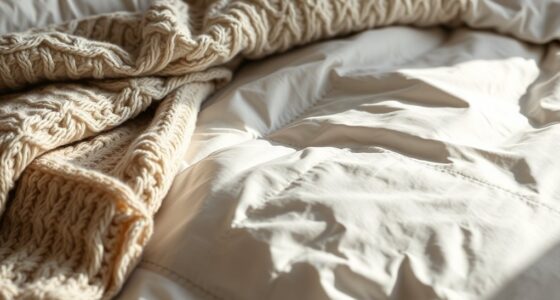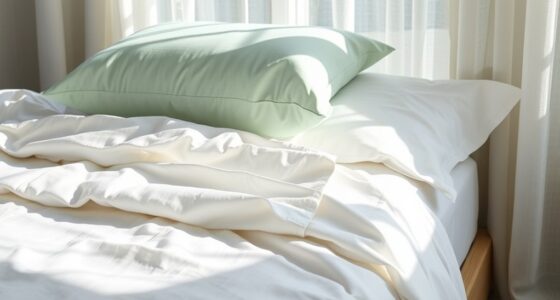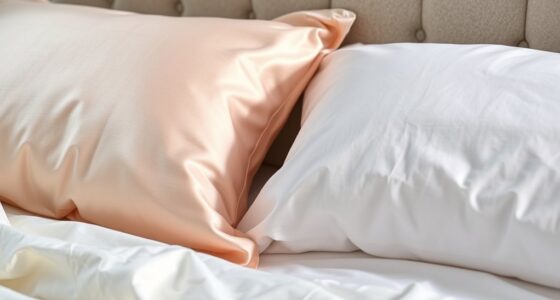Feather pillows are made from larger, stiffer bird quills, giving them a firmer, more supportive feel, while down pillows come from soft, fine clusters beneath the feathers, making them lightweight and plush. Feathers can be prickly if not well processed, whereas high-quality down offers excellent loft and softness. Your choice depends on whether you want more support or a cloud-like feel. Exploring further will reveal how these materials impact comfort, support, and longevity.
Key Takeaways
- Feather pillows contain larger, rigid bird quills, providing firmer support, while down pillows use soft, fine clusters for a plush feel.
- Down pillows are lighter, more lofted, and offer superior insulation compared to the denser, often firmer feather pillows.
- Feather pillows can feel prickly or uncomfortable if made from lower-quality feathers; high-quality options are smoother and softer.
- Down fill power indicates quality; higher fill power means better loft, durability, and a more luxurious, cloud-like softness.
- Feather pillows generally offer more support and structure, whereas down pillows prioritize softness and malleability for a plush sleeping experience.

Are you confused about the difference between feather and down pillows? It’s a common question, and understanding the key distinctions can considerably improve your sleep quality. The main difference lies in the materials used: feathers come from bird quills, while down is the soft layer beneath the feathers. When evaluating these pillows, it’s important to take into account feather quality and down density. Feather quality refers to the overall condition of the feathers, including the size, flexibility, and the presence of any contaminants or sharp quills. High-quality feathers are usually larger, more flexible, and have a smooth surface, which contributes to a softer, more comfortable pillow. Poor-quality feathers, on the other hand, might feel prickly or cause discomfort and may even poke through the pillow cover. Down density, meanwhile, measures how much down fill is packed into the pillow. A higher down density indicates a fluffier, more resilient pillow that offers better support and insulation, while a lower density results in a flatter, less supportive pillow. It’s worth noting that down is prized for its lightweight and lofty qualities, making it ideal for those seeking a plush, luxurious feel. When choosing between feather and down pillows, you should take into account your preferences for support and softness. Feather pillows tend to be firmer because the feathers provide more structure, especially when they are of good feather quality. Down pillows, being softer and more malleable, are perfect for those who prefer a cloud-like sleeping experience. However, some pillows combine both materials, offering a balance of support and softness. It’s also essential to pay attention to the fill power, which indicates the quality of down based on its loft and insulating capacity; higher fill power generally means better quality and durability. Additionally, feather treatment processes can affect allergy sensitivity and overall comfort. If you’re sensitive to allergies, down pillows with high-quality fill and proper hypoallergenic treatments can minimize irritation, while poorly processed feathers might cause discomfort. When shopping, always check for labels indicating the feather quality and down density, as these details will help you find a pillow that matches your sleep needs. Ultimately, understanding these differences allows you to select a pillow that provides the right support, comfort, and durability. Whether you prefer the firm, supportive feel of a feather pillow or the soft, lofty sensation of down, paying attention to feather quality and down density ensures you make an informed decision for a better night’s sleep.
Frequently Asked Questions
Are Feather and Down Pillows Suitable for Allergy Sufferers?
If you’re worried about allergy concerns, feather and down pillows might not be ideal, as they can trap dust mites and allergens. However, hypoallergenic options are available, which are specially treated to reduce allergenic particles. Regular cleaning is essential to manage allergens, but consider hypoallergenic covers for added protection. If you have severe allergies, you might want to explore synthetic or memory foam pillows instead for a safer, cleaner sleep environment.
How Do Feather and Down Pillows Compare in Durability?
You wonder how feather and down pillows compare in durability. In a durability comparison, down pillows often have better material longevity because their finer, more resilient fill maintains shape longer with proper care. Feather pillows, while durable, may require more frequent fluffing to preserve fullness. Overall, if you want a pillow that lasts longer, down tends to hold up better over time, but proper maintenance is key for both types.
Can Feather and Down Pillows Be Washed at Home?
You can wash feather and down pillows at home, but you need to follow proper pillow cleaning and washing techniques. Use a gentle cycle with mild detergent, and avoid harsh chemicals that can damage the filling. It’s best to wash two pillows at once to balance the load. After washing, thoroughly dry your pillows on low heat, and make sure they’re completely dry to prevent mold or mildew growth.
Which Pillow Type Offers Better Temperature Regulation?
Imagine your pillow as a gentle breeze on a warm day. When it comes to temperature regulation, feather pillows often act like a breathable canopy, allowing air to flow freely and keep you cool. Down pillows, on the other hand, trap warmth like a cozy fire, providing insulation. If breathability and staying cool are your priorities, feather pillows usually offer better temperature regulation.
Are There Environmental Impacts Associated With Feather and Down Pillows?
You might wonder about the environmental impacts of feather and down pillows. Both can have issues related to sustainable sourcing, as not all feathers and down are ethically harvested. However, natural materials like these are biodegradable, which reduces long-term waste. Choosing products from brands committed to ethical sourcing helps minimize environmental harm, ensuring your pillow is both eco-friendly and sustainable, without sacrificing comfort or quality.
Conclusion
In the end, choosing between feather and down pillows is like picking a different melody—each offers a unique comfort. Feather pillows provide more support and a firmer feel, while down pillows bring a cloud-like softness that’s light as air. Think of it as selecting your perfect pillow as you’d choose your favorite tune—something that makes you feel cozy and relaxed. Whichever you pick, it’s all about finding the one that cradles you best through the night.









